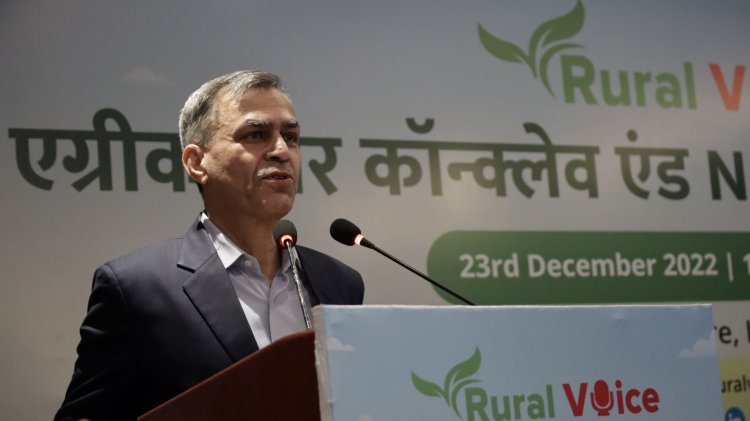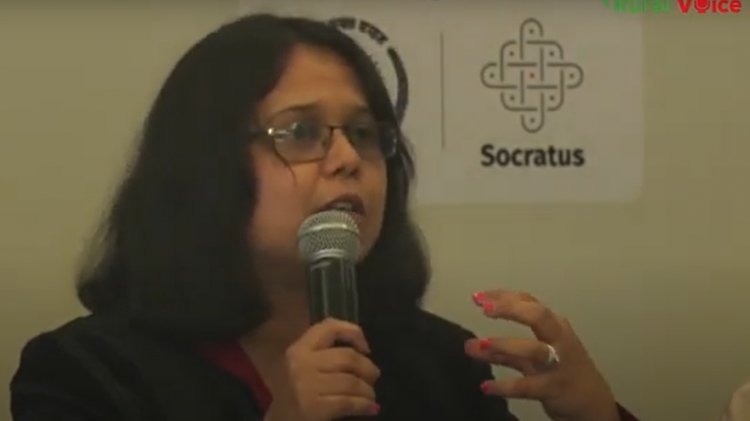The direct relation between cost and yield was top on the agenda at a discussion on 'Technology in boosting agriculture growth and farm incomes' organized by Rural Voice, the interactive digital media platform, to mark its second anniversary. Senior journalist and author Harish Damodaran was the moderator.
Highlighting the need for diversification to generate more income rather than sticking to age-old practices, Dr Trilochana Mohapatra, Chairman NAAS, and former DG ICAR and Secretary DARE, spoke on the important role of research in lowering costs and increasing productivity.
"This alone will help farmers," he stressed, citing examples to substantiate his remark.
Dr Mohapatra said he was on an official visit to the Kangra and Chamba areas of Himachal Pradesh when he came across farmers cultivating wild marigolds. One of them told him that he was employed in Delhi but could not make both ends meet with Rs 15,000 that he got as salary. He quit his job, came back to his home state and organized 100-150 people to cultivate wild marigold flowers. Initially, the oil extracted from the flowers was sold at Rs 5,000-6,000 a litre, but with competition among the oil mills, it started fetching Rs 12,000-15,000 a litre.
Moreover, the cultivators who earlier complained of monkey menace while growing other crops did not face any such issue with wild marigolds and were earning up to Rs 60,000 in six months of lean period, depending upon the size of their land.
“The inference, therefore, is to diversify because traditional farming may not generate that much income. Moreover, along with income, employment, too, is generated,” Dr Mohapatra said.
"It is time to think of diversification when traditional farming is not giving much profit," he suggested and stressed that the state government and the Centre can help in encouraging farmers to diversify.
Dr Mohapatra said that the Krishi Vigyan Kendras (KVKs), thanks to support from ICAR, were involved in doubling farmers’ income and pointed out that the horticulture sector played a major role in this direction, with farmers growing exotic vegetables that raised their income even four to five times. After horticulture, it was dairy that generated more income for the farmers. Dr Mohapatra also referred to the efforts of the Sugarcane Breeding Institute in Coimbatore (TN) for higher yield.
He said that if the right technology was used, the cost could be minimized and production maximized. He advocated a cluster farming approach for better results.

Dr Harsh Kumar Bhanwala, Chairman MCX and former Chairman NABARD, said that the use of satellites could help farmers.
With the help of technology, farmers need not travel to banks, losing a day's income and spending from their pockets on transportation and food, because now everything is available at the click of a mouse, he said. From employment to marriage, everything has been simplified with the help of technology.
Payments can be done or received sitting at home, he said, underlining the importance of technology that promotes a unified payment system. The RBI is there to check any fraud in transactions with the help of an ombudsman.
Start-ups, said Bhanwala, are eliminating the large number of middlemen. “Why not get associated with them — directly or through FPOs — and reduce your costs?”
Bhanwala also pointed to the need for diversification. He said, “I have travelled across the country and found that our area (Haryana and adjacent states) has the least diversification. If you want to see diversification, look at the states that cultivate various crops despite scarcity of resources.” He referred to the states of Tamil Nadu, Andhra Pradesh and Maharashtra.
He suggested that it was high time start-ups came out with some ideas to provide health insurance to farmers rather than looking up to the government for medical assistance in times of dire need.
Roshan Lal Tamak, Executive Director and CEO - Sugar Business, DCM Shriram Limited, spoke on measures to boost productivity by removing certain hurdles in farming. He pointed to the various interventions necessary at different stages of the sugarcane crop cycle.
The prizewinners, said Tamak, had an average cane yield of about 2,500 quintals per hectare while the average production of the state was 75 tonnes per hectare. Besides, there were wide variations in different regions across the state. Why is the average production so low in spite of the protection in our water, land and climate, he asked.
Tamak went into the reasons for this. One, we have hardly had 5-6 good varieties in the last five to six decades. A robust pipeline is needed to develop varieties. Co 0238 should further develop into a super variety. Two, we must distinguish between seed and cane. It is a wrong practice to plant canes indiscriminately because “as you sow, so shall you reap.”
Three, the sowing method. Trench planting certainly increases the yield by 10-15 per cent. The gap between rows reduces the competition between plants for air, sunlight, water and fertilizers. Four, the foliage spray method definitely increases fertilizer efficiency. Spraying them uniformly using drone technology is what is needed.
Next is the need for mechanization as we neither get labourers nor do we have the stamina. ICAR plays a big role here in introducing machines at various stages of the crop cycle. Again, in irrigation, electrification and solarization will have major roles. Tamak said that irrigation using solar energy could reduce costs to a great extent.

Speaking on profitability as the main concern before farmers, Dr Renuka Diwan, Director, BioPrime AgriSolutions Pvt Ltd, said that 40 per cent of the money invested in cultivation got wasted and only 60 per cent was used gainfully for getting yield.
"Our effort is to ensure curtailment of the loss to 10 per cent if not zero as healthy crops need less spray of insecticide and less use of fertilizers, and on the other hand ensure higher yield and good quality harvest," she said.
All these together lead to fetching good prices in the market, she said.
Murugan Chidhambaram, Head of Digital Transformation and Marketing, Aquaconnect, said that India was now the second major shrimp exporter.
"We are connected with retailers who are connected with farmers. That is, we are in middleman activity," he said.
He described technology as "A and A" — the first 'A' is for Ancestors' Intelligence and the second 'A' for Artificial Intelligence.
Chidhambaram said that by clubbing manual information with remote sensing and satellite images, the agriculture sector could benefit a lot.
He also said that technology could help in a sustainable way of farming and de-risk farmers' monetary issues and at the same time speed up the blue revolution.